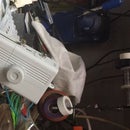Introduction: Socapex Style Multicable Tester
As I've mentioned before, I'm the repair gnome in the back of the shop for a theater lighting rental company. One of the things we have in inventory is miles and miles of power cables. All of which fail from time to time and have to be tested.
There are commercially made testers out there, but they suffer from feature creep and price inflation. The tester we had been using had been dropped and repaired too many times, so I decided it was time to make a new one, with some improvements.
Step 1: Parts and Design.
I wanted a single button to put voltage down each given wire, and leds for all the wires, to detect shorts internal to the cable. So we got prices and parts, some from the junk box and some we had to buy.
So a good sized project box, metal for durability. Male and female panel mount connectors. An led, push button and resister for each pin on the conector. Plus one for a test button. Battery holder and a bunch of hookup wire from some obsolete control cables.
Laid out a couple of designs layouts and showed them around the shop for votes on which one was best. Picked out the layouts that matched the connector pin layout.
Step 2: Prep, Painting and Making Holes.
First I cleaned the box, primed and a couple of coats of nice bright red paint. Let the paint dry over the weekend so it would be nice and hard when I started drilling.
Laid out some blue painters tape on the surfaces and laid out the holes and such on the blue tape. So if I made a mistake I could just retape and redo it.
Drilled holes, used a knockout punch to do the large holes, and did the rectangular hole for the battery holder with a small die grinder with a cutout wheel. First irreversible mistake. Put the hole for the battery holder through a structural support for the box. Should have offset it to avoid that.
Once all the holes were done and edges smoothed out, I printed out labels using clear p-touch tape. Applied the labels then took it back to the paint booth for another couple coats of clear lacquer as a topcoat and to protect the labels. Let that dry for a couple days to cure hard.
Step 3: Soldering Madness
Installed all the switches and the battery holder. Soldered one lead from the battery to one pole of each switch. The other pole of each switch gets wired to the corresponding pin on the female connector.
Don't make the mistake of forgetting that the numbers are mirror image on the backside like I did.
Leds got glued into their holes with some clear rtv silicone. Bent and soldered the negative leads to each other and then wired to the negative pole of the battery holder. The other lead from the leds each got a resister and some shrink tubing on it, then wired to the appropriate pin on the male connector. After I had soldered them to the wrong pins and had to figure out why it was giving me such unexpected wrong results.
Test button, resister and led got wired up mostly to allow one to test if the battery has gone dead or not.
Step 4: Finishing Up.
Finished it up and tested it. Then fixed my mirror image wiring job. Oops. Also discovered an unexpected fault on the supposedly good cable that I was using for testing. My guess is that the battery will not need replacing for a few years, the LEDs use so little power and they are just going to be on for a moment when it use.
Step 5: Thoughts After Using It for a Few Weeks.
So, been using it in the shop for a few weeks. Additional features I'd like to add would be a stage pin male and female on the box, so I can test the break in and break out cables. But that would be feature creep, so probably won't do that.
After using it on my workbench for a couple years, I made the mistake of letting a visiting crew borrow it to test the cables they were putting into their prerig cable looms. they tested them alright. Plugged the male end into a dimmer and plugged my low voltage box into the other end. I hope that he at least pissed his pants when full line current was applied and it made the sound of angry pixies and emitted the magic smoke. What really annoyed me was that he went and hid it instead of bringing it back and apologizing. I didn't find it until the following week hidden behind some junk in a drawer.
I ended up replacing all the LEDs and resistors, and all of the small internal wires as trying to figure out which ones were burned up or still good was more effort than just replacing them all. Fortunately, the LEDs and resistors came in a pack of 100, so I had plenty of spares.













